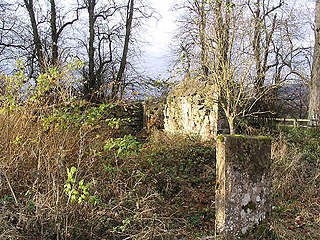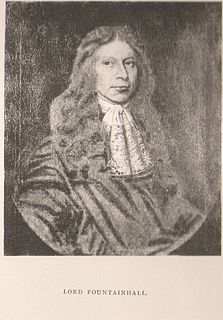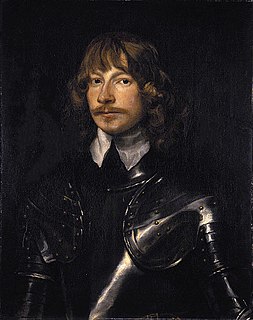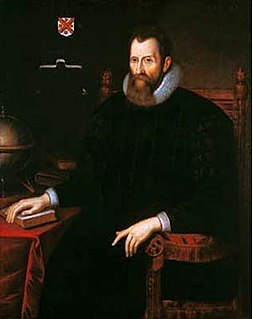 W
WSir Robert Kerr, 1st Earl of Ancram, was a Scottish nobleman, English politician and writer.
 W
WPatrick Anderson, was a physician and author.
 W
WJohn Arbuthnot FRS, often known simply as Dr Arbuthnot, was a Scottish physician, satirist and polymath in London. He is best remembered for his contributions to mathematics, his membership in the Scriblerus Club, and for inventing the figure of John Bull.
 W
WArchibald Campbell, 1st Marquess of Argyll, 8th Earl of Argyll, Chief of Clan Campbell was a Scottish nobleman, politician, and peer. The de facto head of Scotland's government during most of the conflict of the 1640s and 50s known as the Wars of the Three Kingdoms, he was a major figure in the Covenanter movement that fought for the maintenance of the Presbyterian religion against the Stuart monarchy's attempts to impose episcopacy. He is often remembered as the principal opponent of the royalist general James Graham, 1st Marquess of Montrose.
 W
WJohn Barclay was a Scottish writer, satirist and neo-Latin poet.
 W
WAdam Blackwood (1539–1613) was a Scottish author and apologist for Mary, Queen of Scots.
 W
WZachary Boyd (1585–1653) was a Scottish minister and university administrator who wrote many sermons, scriptural versifications and other devotional works. He served as Dean of Faculties, Rector and Vice-Chancellor at the University of Glasgow during the 1630s and 1640s, and bequeathed a generous legacy to the University including his library and large manuscript collection of unpublished sermons and verse.
 W
WDavid Calderwood was a Church of Scotland minister and historian. Calderwood was banished for his nonconformity, he found a home in the Low Countries, where he wrote his great work, the Altare Damasccnum. It was a serious attack on Anglican Episcopacy. Patiently and perseveringly Calderwood goes over the whole. The Bible, the Fathers, and the Canonists, are all referenced. Calderwood lived to see the principles for which he had suffered, and which he had defended, in complete ascendency. He was present at the Glasgow Assembly in 1638, and saw Prelacy and the Ceremonies swept away. He breathed his last at Jedburgh, a fugitive from his parish of Pencaitland; and they laid him in the churchyard of Crailing, where the first years of his ministry were spent.
 W
WThomas Dempster was a Scottish scholar and historian. Born into the aristocracy in Aberdeenshire, which comprises regions of both the Scottish highlands and the Scottish lowlands, he was sent abroad as a youth for his education. The Dempsters were Catholic in an increasingly Protestant country and had a reputation for being quarrelsome. Thomas' brother James, outlawed for an attack on his father, spent some years as a pirate in the northern islands, escaped by volunteering for military service in the Low Countries and was drawn and quartered there for insubordination. Thomas' father lost the family fortune in clan feuding and was beheaded for forgery.
 W
WJames Forbes (c.1629–1712) was a Scottish nonconformist divine.
 W
WSir John Lauder of Fountainhall, 2nd Baronet, Lord Fountainhall was one of Scotland's leading jurists who remains to this day an oft consulted authority. He was knighted in 1680 and matriculated his Arms with the Lyon Court on 15 June 1699.
 W
WAlexander Gibson, Lord Durie I was a Scottish judge and legal writer.
 W
WEsther Inglis (1571–1624) was a skilled member of the artisan class, as well as a miniaturist, who possessed several skills in areas such as calligraphy, writing, and embroidering. She was born in 1571 in either London or in Dieppe and was later relocated to Scotland, where she was later raised and married. Sharing similarities with Jane Segar, Inglis always signed her work and frequently included self-portraits of herself in the act of writing. However, unlike Jane Segar, Inglis successfully established a career based on manuscript books created for royal patrons. Over the course of her life, Inglis composed around sixty miniature books that display her calligraphic skill with paintings, portraits, and embroidered covers. She mostly dedicated her books to the monarchs, Elizabeth I and James VI and I, and people in power during their reign. She died around 1624, at the age of 53.
 W
WJames VI and I was King of Scotland as James VI from 24 July 1567 and King of England and Ireland as James I from the union of the Scottish and English crowns on 24 March 1603 until his death in 1625. The kingdoms of Scotland and England were individual sovereign states, with their own parliaments, judiciaries, and laws, though both were ruled by James in personal union.
 W
WWilliam Lithgow was a Scottish traveller, writer and alleged spy. He claimed at the end of his various peregrinations to have tramped 36,000 miles (57,936km) on foot.
 W
WLady Anna Mackenzie (1621–1707) was a Scottish courtier and memoirist, wife of the first Earl of Balcarres and the mother of the second and third. After her first husband died, she married Archibald Campbell, 9th Earl of Argyll. She was a governess to William III when he was a child. Mackenzie suffered because she was a Jacobite and her second husband was executed for leading a rising against James VII and II which was intended to support the Monmouth Rebellion. She worked to keep together the estates of Balcarres despite the tumultuous times in which she lived and her family's support of the Jacobite cause. Her memoirs were published more than a century after her death.
 W
WElizabeth Melville, Lady Culross (c.1578–c.1640) was a Scottish poet.
 W
WJames Graham, 1st Marquess of Montrose was a Scottish nobleman, poet and soldier, lord lieutenant and later viceroy and captain general of Scotland. Montrose initially joined the Covenanters in the Wars of the Three Kingdoms, but subsequently supported King Charles I as the English Civil War developed. From 1644 to 1646, and again in 1650, he fought in the civil war in Scotland on behalf of the King. He is referred to as the Great Montrose.
 W
WRobert Mylne was a Scottish writer of pasquils, and antiquary. He is generally described as a writer of Edinburgh, but also as an engraver.
 W
WJohn Napier of Merchiston, nicknamed Marvellous Merchiston, was a Scottish landowner known as a mathematician, physicist, and astronomer. He was the 8th Laird of Merchiston. His Latinized name was Ioannes Neper.
 W
WAlexander Ross was a prolific Scottish writer and controversialist. He was Chaplain-in-Ordinary to Charles I.
 W
WWilliam Alexander, 1st Earl of Stirling was a Scottish courtier and poet who was involved in the Scottish colonisation of Habitation at Port-Royal, Nova Scotia and Long Island, New York. His literary works include Aurora (1604), The Monarchick Tragedies (1604) and Doomes-Day.
 W
WGeorge Wishart (1599–1671) was a Scottish Anglican bishop and author.